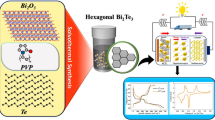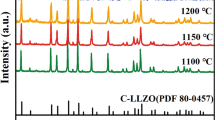Abstract
The volatilization of bismuth (Bi) species and bismuth oxide (Bi2O3) leads to the presence of the oxygen vacancies (V 00O ) and consequently restrains the properties of bismuth titanate (BIT; Bi4Ti3O12). This report presents the incorporation of different atomic ratios of praseodymium ion (Pr3+: x = 0, 0.2, 0.4, 0.6, 0.8 and 1.0) into the BIT (Bi4−x Pr x Ti3O12) ceramics through an intermediate fuel agent-assisted self-combustion synthesis (IFSC). X-ray diffraction and Raman spectroscopy results revealed that some of bismuth ion (Bi3+) in the pseudo-perovskite layer containing Ti–O octahedra was substituted by Pr3+ ion. The substitution by ion with a smaller ionic radius caused the structure distortion and consequently resulted in the phase transformation from an orthorhombic symmetry to a tetragonal symmetry. Besides, it suppressed the volatilization of Bi and Bi2O3 and increased the stability of metal–oxygen octahedra in the BIT. These play a crucial role to control the crystal growth, as well as limit the V 00O . Dense ceramic with a relative density up to 96.2% was obtained by incorporating Pr3+ with atomic ratio of 1.0. It exhibited high dielectric constant as 908.19 and low dissipation factor as 0.0011. The results address the possibility to control the structure, morphology and dielectric properties of BIT ceramic by incorporating Pr3+ ion through IFSC.








Similar content being viewed by others

References
Yueming L, Wen C, Qing X, Jing Z (2007) Ceram Int 33:95
Hyatt NC, Hriljac JA, Comyn TP (2003) Mater Res Bull 38:837
Subbarao EC (1961) Phys Rev 122:804
Hou J, Kumar RV, Qu Y, Krsmanovic D (2009) J Nanopart Res 12:563
Villegas M, Jardiel T, Caballero AC (2009) J Eur Ceram Soc 29:737
Lazarevic ZZ, Romcevic NZ, Bobic JD, Romcevic MJ, Dohcevic-Mitrovic Z, Stojanvic BD (2009) J Alloys Compd 486:848
Lazarevic ZZ, Stojanvic BD, Paiva-Santos CO, Romcevic NZ (2008) Ferroelectric 368:154
Tang Q-Y, Kan Y-M, Li Y-G, Zhang G-J, Wang P-L (2006) Sci Mater 54:2075
Simoes AZ, Quinelato C, Ries A, Stojanovic BD, Longo E, Varela JA (2006) Mater Chem Phys 98:481
Takahashi M, Noguchi Y, Miyayama M (2005) J Ceram Process Res 6:281
Yoneda Y, Kohara S, Mizuki J (2006) J Appl Phys 45:7556
Park BH, Kang BS, Bu SD, Noh TW, Lee J, Jo W (1999) Nature 401:682
Yamada M, Iizawa N, Yamaguchi T, Sakamoto W, Kikuta K, Yogo T, Hayashi T, Hirano S-I (2003) Jpn J Appl Phys 42:5222
Cheng CP, Tang MH, Ye Z, Zhong XL, Zheng XJ, Zhou YC, Hu ZS (2007) Mater Lett 61:3563
Chen Y-C (2006) Thin Solid Films 513:331
Kim JK, Kim J, Song TW, Kim SS (2002) Thin Solid Films 419:225
Goh PY, Razak KA, Sreekantan S (2009) J Alloys Compd 475:758
Krengvirat W, Sreekantan S, Ahmad-Fauzi MN, Matsuda A, Chinwanitcharoen C (2012) J Ceram Soc Jpn 120:1
Achary SN, Patwe SJ, Krishna PSR, Shinde AB, Tyagi AK (2008) J Phys 71:935
Kim JS, Lee SY, Lee HJ, Ahn CW, Kim WI, Jang MS (2008) J Electroceram 21:633
Simoes AZ, Stojanovic BD, Ramirez MA, Cavalheiro AA, Longo E, Varela JA (2008) Ceram Int 34:257
Moore JJ, Yi HC (1990) J Mater Sci 25:1159. doi:10.1007/BF00585421
Du X, Xu Y, Ma H, Wang J, Li X (2007) J Am Ceram Soc 90:1382
Wang X-H, Chen R-Z, Gui Z-L, Li LT (2003) Mater Sci Eng B 99:199
Wang YH, Huang CP, Zhu YY (2006) Solid State Commun 138:229
Du YL, Zhang MS, Chen Q, Yuan ZR, Yin V, Zhang QA (2002) Solid State Commun 124:113
Wang Y, Xu G, Zhang X, Tang W, Cheng G, Zhu Y (2004) Mater Lett 58:813
Oliveira RC, Cavalcante LS, Sczancoski JC, Aguiar EC, Espinosa JWM, Varela JA, Pizani PS, Longo E (2009) J Alloys Compd 478:661
Luo S, Tang Z, Yao W, Zhang Z (2003) Microelectron Eng 66:147
Ng CY, Razak KA (2011) J Alloys Compd 509:942
Razak KA, Cheah JY, Sreekantan S (2011) J Alloys Compd 509:2936
Krengvirat W, Sreekantan S, Ahmad-Fauzi MN, Chinwanitcharoen C, Hiroyuki M, Atsunori M (2011) J Ceram Int. doi:10.1016/j.ceramint.2011.11.081
Hervoches CH, Lightfoot P (1991) Chem Mater 11:3359
Zarycka A, Lisinska-Czekaj A, Czuber J, Orkisz T, Ilczuk J, Czekaj D (2005) Mater Sci-Pol 23:167
Graves PR, Hua G, Myhra S, Thompson JG (1995) J Solid State Chem 114:112
Ling ZC, Xia HR, Liu WL, Han H, Wang XQ, Sun SQ, Ran DG, Yu LL (2006) Mater Sci Eng B 128:156
Zhou D, Gu H, Hu Y, Qian Z, Hu Z, Yang K, Zou T, Wang Z, Guan J, Chen W (2010) J Appl Phys 107:094105-1, 094105-3–094105-6
Watcharapasorn A, Siriprapa P, Jiansirisomboon S (2009) J Eur Ceram Soc 30:87
Chon U, Shim JS (2003) J Appl Phys 93:4769
Buessem WR, Cross LE, Goswami AK (1996) J Am Ceram Soc 49:33
Arlt G (1989) Ferroelectrics 91:3
Kong LB, Ma J, Zhu W, Tan OK (2001) Mater Lett 51:108
Coondoo I, Jha AK, Agarwal SK (2007) Ceram Int 33:41
Simoes AZ, Pianno RF, Riccardi CS, Cavalcante LS, Longo E, Varela JA (2008) Ceram Int 454:66
Takahashi M, Noguchi Y, Miyayama M (2005) Ceram Process Res 6:281
Gachigi KW, Kumar U, Dougherty JP (2002) ISAF ‘92, Proc Eighth IEEE Int Symp Appl 492–495
Acknowledgements
The authors like to thank Universiti Sains Malaysia for sponsoring this work under a 2008 short-term grant (6035276) and the ASEAN University Network for Science and Engineering Education (AUN/SEED-net) (6050151).
Author information
Authors and Affiliations
Corresponding author
Rights and permissions
About this article
Cite this article
Krengvirat, W., Sreekantan, S., Ahmad-Fauzi, M.N. et al. Control of the structure, morphology and dielectric properties of bismuth titanate ceramics by praseodymium substitution using an intermediate fuel agent-assisted self-combustion synthesis. J Mater Sci 47, 4019–4027 (2012). https://doi.org/10.1007/s10853-012-6255-z
Received:
Accepted:
Published:
Issue Date:
DOI: https://doi.org/10.1007/s10853-012-6255-z



